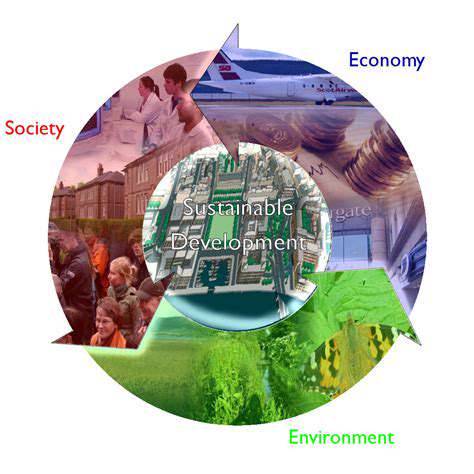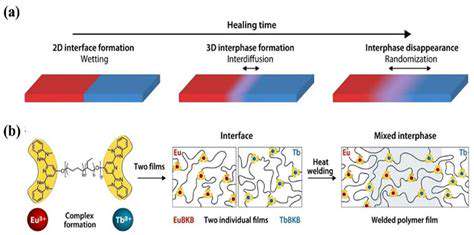Solar Energy: Beyond Silicon: Exploring New Materials
Beyond Silicon: Exploring Novel Solar Materials
The quest for more efficient and sustainable solar energy solutions has driven significant research into materials beyond the traditional silicon-based photovoltaic cells. This exploration encompasses a wide range of materials with unique properties, offering the potential to overcome some of the limitations of existing technologies. Researchers are investigating various compounds, including organic semiconductors, quantum dots, and perovskites, each with the potential to enhance light absorption, charge transport, and overall power conversion efficiency. Understanding the intricacies of these materials' electronic structure and their interactions with light is crucial for developing advanced solar cells that can effectively capture and utilize solar energy.
The development of novel solar materials is not merely about improving efficiency; it's also about reducing manufacturing costs and environmental impact. Many traditional silicon-based solar cells rely on complex and energy-intensive processes. Emerging materials, with their diverse chemical structures and potential for low-cost fabrication methods, offer a path towards more environmentally friendly and economically viable solar energy solutions. This shift towards innovation in materials science is vital for meeting the growing global demand for renewable energy sources and addressing the climate crisis.
The Potential of Perovskites and Other Advanced Materials
Perovskite solar cells have garnered significant attention in recent years due to their remarkable power conversion efficiencies and relatively simple fabrication processes. These materials, with their unique crystal structures, exhibit exceptional light absorption properties, potentially surpassing silicon in terms of efficiency. Furthermore, perovskites' tunable optoelectronic properties open up possibilities for tailoring their characteristics to specific applications, such as flexible solar cells and tandem solar cell architectures. However, long-term stability and scalability remain key challenges that researchers actively address.
Beyond perovskites, other advanced materials like quantum dots and organic semiconductors hold promise for solar energy applications. Quantum dots, with their size-dependent optical properties, can absorb a wider range of wavelengths in the solar spectrum. Organic semiconductors, meanwhile, offer the potential for flexible and low-cost manufacturing processes, opening doors for novel solar cell designs. The ongoing research into these materials aims to overcome their current limitations, such as stability issues and material purity concerns, to pave the way for more versatile and efficient solar energy technologies.
Understanding the interplay between material properties and device architecture is critical for maximizing the performance of these advanced solar cells. Researchers are also investigating ways to integrate these emerging materials with existing technologies, potentially achieving higher efficiencies and opening new avenues for solar energy harvesting and utilization. The exploration of these new materials is a testament to the continuous drive for innovation in solar energy research, promising a future where solar power becomes even more readily available and effective.
The diversity of these advanced materials, coupled with the ongoing development of novel fabrication techniques, suggests a promising future for solar energy. This exploration will be critical in achieving a sustainable energy future, providing a reliable and environmentally friendly alternative to fossil fuels.
Perovskite Solar Cells: A Promising Frontier
Perovskite Materials: A Novel Approach
Perovskite materials, a class of hybrid organic-inorganic compounds, have emerged as a revolutionary material for solar cell applications. Their unique crystal structure, combining the advantages of both organic and inorganic components, allows for tunable properties, enabling researchers to tailor the material's absorption spectrum to maximize light harvesting. This remarkable feature sets them apart from traditional silicon-based solar cells, opening doors to potentially higher efficiencies and reduced manufacturing costs.
The unique structure of these materials allows for a wide range of potential applications beyond just solar cells. The ability to fine-tune their properties through varying the organic and inorganic components suggests they could be utilized in a variety of optoelectronic devices, making them a promising area of research.
Efficiency Gains and Cost-Effectiveness
One of the most compelling aspects of perovskite solar cells is their potential for high efficiency. Early research has shown remarkable performance improvements, exceeding the efficiencies of traditional silicon-based solar cells in certain laboratory settings. This potential for increased efficiency, combined with the promise of lower manufacturing costs compared to silicon, makes them a compelling alternative to existing technologies.
The lower production costs are primarily attributed to the relative simplicity and low-temperature processing of perovskite materials. This contrasts sharply with the high-temperature processes required for silicon production, significantly reducing the overall manufacturing expenses.
Stability Challenges and Future Directions
Despite the promising performance and cost-effectiveness, perovskite solar cells currently face challenges related to their long-term stability. These materials are susceptible to degradation from moisture, oxygen, and light, limiting their lifespan in real-world applications. Overcoming these stability issues is crucial for widespread adoption and commercialization.
Material Design and Optimization
Researchers are actively engaged in material design and optimization strategies to enhance the stability of perovskite solar cells. This includes incorporating protective layers, exploring new material compositions, and refining the manufacturing processes. These efforts are aimed at addressing the critical issue of long-term performance and durability.
Applications Beyond Solar Cells
The versatility of perovskite materials extends beyond their application in solar cells. Their tunable properties make them attractive for other optoelectronic devices, including light-emitting diodes (LEDs), photodetectors, and lasers. This broader range of applications signifies the potential for a wider impact on various technological fields, beyond just renewable energy.
Environmental Impact and Sustainability
The environmental impact of perovskite solar cell production is an important consideration. The use of environmentally friendly materials and processes in their manufacturing is a key aspect in ensuring sustainability. Minimizing the environmental footprint associated with their production is essential for their acceptance as a sustainable energy solution.
Research and Development in the Field
Significant research and development efforts are ongoing to address the challenges associated with perovskite solar cells. The collaborative nature of this field brings together researchers from various disciplines, including materials science, chemistry, and engineering, to drive innovation and accelerate progress. This collaborative spirit fosters progress and new insights into the complexities of these novel materials.
Organic and Quantum Dot Solar Cells: Flexibility and Broad Spectrum Absorption

Organic Solar Cells: A Promising Alternative
Organic solar cells (OSCs) are a rapidly emerging field in photovoltaic technology, offering a compelling alternative to traditional silicon-based cells. Their lightweight, flexible nature, and potential for low-cost manufacturing make them highly attractive for various applications, including flexible electronics and large-area installations. OSCs utilize organic materials, such as conjugated polymers and small molecules, to absorb sunlight and convert it into electricity. These materials exhibit unique electronic properties that enable efficient charge separation and transport within the device.
However, the current efficiency of OSCs still lags behind that of silicon solar cells. Overcoming this efficiency hurdle is a major focus of current research and development, aiming to improve the stability and long-term performance of these devices. Researchers are exploring different materials, device architectures, and processing techniques to enhance their power conversion efficiency and broaden their applicability.
Quantum Dot Solar Cells: Harnessing Nanomaterials
Quantum dot (QD) solar cells represent another innovative approach to photovoltaic technology. These cells leverage the unique properties of semiconductor nanocrystals, known as quantum dots, to absorb and convert sunlight into electricity. QD solar cells hold great promise due to their tunable optical properties, allowing for efficient absorption across a broader range of the solar spectrum. This capability could potentially lead to higher overall energy conversion efficiencies compared to conventional solar cells.
The use of quantum dots allows for the creation of highly efficient light absorbers and, more importantly, efficient charge separation and collection. However, challenges remain in achieving high manufacturing yields and controlling the long-term stability of QD solar cells. Further advancements in material synthesis and device engineering are necessary to overcome these obstacles.
Material Considerations in Both Technologies
A key aspect of both organic and quantum dot solar cells is the selection of appropriate materials. The choice of materials directly impacts the efficiency, stability, and cost-effectiveness of the solar cell. Organic materials must possess excellent charge transport properties and long-term stability in the presence of environmental factors. QD materials need to exhibit high absorption coefficients and efficient charge separation, while also maintaining their structural integrity during device operation.
Device Architecture and Fabrication
The design and fabrication of the device architecture significantly influence the performance of both organic and quantum dot solar cells. Optimizing the active layer structure and the interfaces between different materials is crucial for maximizing charge separation and collection. Advanced techniques in layer deposition and patterning are critical for achieving high-quality devices with consistent performance. Furthermore, the fabrication process itself must be cost-effective to ensure widespread adoption.
Future Prospects and Applications
Both organic and quantum dot solar cells hold immense potential for future renewable energy applications. The flexibility and low manufacturing costs of organic solar cells make them ideal for integration into flexible electronics and large-area installations. Quantum dot solar cells, with their potential for high efficiency and broad spectral response, may prove particularly useful in niche applications where high performance is paramount. Further research and development in both areas will be crucial for realizing their full potential in a sustainable energy future.
Metal Oxides and Other Novel Approaches
Metal Oxides: A Promising Alternative
Metal oxides, a diverse class of inorganic compounds, offer a compelling alternative to silicon in solar cell technology. Their unique electronic structures and tunable properties allow for the development of materials with tailored band gaps, enabling efficient light absorption across a broader portion of the solar spectrum. This opens up the possibility of harvesting a wider range of solar energy, potentially increasing overall energy conversion efficiency. Further research into doping and surface modifications can enhance their performance even further, leading to more cost-effective and environmentally friendly solar energy solutions.
Different metal oxides exhibit varying optoelectronic properties, making them suitable for different applications. For instance, titanium dioxide (TiO2) is known for its high photocatalytic activity, while zinc oxide (ZnO) possesses excellent transparency and conductivity, making it a promising candidate for transparent solar cells. Exploring these diverse properties and combining them with innovative fabrication techniques is crucial for achieving breakthroughs in solar cell technology.
Novel Approaches: Expanding the Horizons
Beyond metal oxides, a plethora of novel approaches are being explored to push the boundaries of solar energy beyond silicon-based systems. These approaches encompass various innovative materials and techniques, such as quantum dots, perovskites, and organic photovoltaics. These alternative materials often exhibit unique optical and electronic properties that can lead to improved light absorption, charge separation, and transport efficiencies. The potential advantages of these new materials lie in their potential to create more flexible, lightweight, and cost-effective solar cell designs, opening up new avenues for energy harvesting.
Researchers are also investigating the integration of nanostructures and novel interfacial engineering to optimize the performance of these alternative solar cells. This involves manipulating the nanoscale dimensions of materials to enhance light trapping and charge carrier transport. The ability to tailor these materials and structures promises to unlock new possibilities for achieving higher efficiencies and wider applicability in various energy-related applications, including building-integrated photovoltaics.
Another promising avenue is the exploration of tandem solar cells. Combining different types of solar cells, each optimized for a specific portion of the solar spectrum, can maximize energy conversion efficiency. This strategy could potentially leverage the strengths of both traditional and novel materials to achieve significant improvements in overall performance.
The development of novel materials and architectures is crucial for achieving high efficiency and low cost in solar cells. The ongoing research and development efforts in these areas promise to accelerate the transition to a more sustainable energy future.
Innovations in fabrication techniques, such as solution processing and printing methods, are also being investigated to reduce manufacturing costs and increase scalability. These advancements can lead to more accessible and affordable solar energy solutions, making solar power more readily available for a wider range of applications.
Read more about Solar Energy: Beyond Silicon: Exploring New Materials
Hot Recommendations
- Offshore Wind for Industrial Power
- Agrivoltaics: Dual Land Use with Solar Energy Advancements: Sustainable Farming
- Hydrogen as an Energy Storage Medium: Production, Conversion, and Usage
- Utility Scale Battery Storage: Successful Project Case Studies
- The Role of Energy Storage in Grid Peak Shaving
- The Role of Startups in Renewable Energy
- The Role of Blockchain in Decentralization of Energy Generation
- The Future of Wind Energy Advancements in Design
- Synchronous Condensers and Grid Inertia in a Renewable Energy Grid
- Corporate Renewable Procurement for Government Agencies






